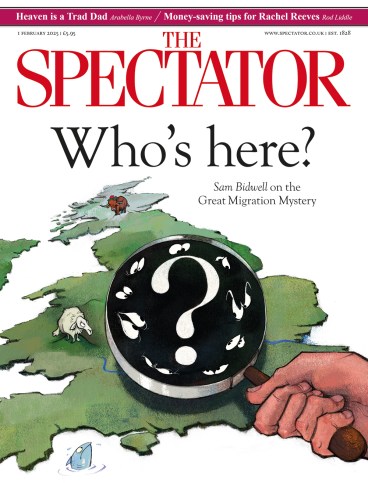
How many people live in Britain? You would think there would be a straightforward answer, but it eludes some of the nation’s brightest statistical minds.
The problem of undercounting has worsened in recent years, largely because of high post-Brexit migration
This week the Office for National Statistics (ONS) projected that our population will grow by some 4.9 million people over the next seven years, bringing Britain’s official population to over 70 million. The bulk of that population growth will come from immigration – nearly ten million people.
But can these projections be trusted? Never mind how many people will live in Britain in seven years, we do not know how many people are living here now. This is despite the fact that – going by the number of CCTV cameras per (estimated) capita – Britons are among the most surveilled people in the world. Big Brother may be watching, but he isn’t counting.
While the ONS does produce mid-year population estimates, these are often considerably wide of the mark. The last national census, in the spring of 2021, proved that point. The total reported population was off by nearly 300,000 from the ONS’s estimate for the year.
Other estimates fare even worse. The Annual Population Survey, which samples about 150,000 households nationwide, has seen response rates plummet from around half in 2017 to less than one in five last year. The APS is so useless that its national statistical accreditation was suspended in October.
Unlike some other countries, such as Sweden, Britain has no centralised population register. We don’t count people in or out of the country, so our population figures are based on rough estimates. Imposing such checks at the border is more difficult than it sounds. Dual passport holders and the UK-Ireland Common Travel Area both present logistical hurdles.
If the British state is bad at population estimates, the private sector is no better. A recent report conducted by Edge Analytics on behalf of Thames Water suggested that as many as one in 12 people could be living in London illegally. However, the methodology was far from robust. Rather than measuring actual water usage, it used out-of-date migration estimates from 2017 and assumed the irregular migrant population peaked the previous year.
Yet even though no company or organisation can give a complete picture of how many people are in the country or who they are, one trend is clear. Whenever official population figures are tested against real-world data, the population is almost always undercounted.
In England alone, nearly 64 million patients are registered with GP practices, higher than the ONS’s estimated national population of 58 million. In 2021, NHS figures indicated a Covid vaccination rate of more than 100 per cent in some areas. In other words, more people had received Covid jabs than were registered as NHS patients.
The problem of population undercounting isn’t new, but it has worsened in recent years, largely because of unusually high post-Brexit migration (both legal and illegal). The surge of non-EU migrants after the end of the Covid lockdowns – the so-called ‘Boriswave’ – represented such a radical increase in numbers that statisticians have struggled to keep up. The ONS’s estimate for net migration in 2022 alone has been revised upwards three times, from an initial figure of 606,000 to 872,000.
This estimate is mostly for legal migrants. Illegal migrants are even harder to track. Though discussions about illegal immigration often focus on the ‘small boats’ crossing the Channel, this is not the only way to achieve undocumented residence in the UK. The vast majority of illegal immigrants arrive legally and then overstay their visas. Many of these overstayers fade into the ‘grey market’, taking up unofficial positions in the gig economy and renting from landlords who are willing to turn a blind eye.
The state’s record at removing these illegal migrants is remarkably poor. The number of ‘enforced returns’ has fallen sharply in the past 20 years, from 21,425 in 2004 to a mid-pandemic low of around 3,000. Last year’s figure of 7,706 represents a slight improvement, but it is still well below the pre-pandemic average.
Many visa overstayers fade into the ‘grey market’, taking up unofficial positions in the gig economy
If 7,706 returns sounds low, that’s because it is. Though estimates range widely, the latest figures suggest that Britain could be home to 745,000 illegal immigrants. That’s more than any other country in Europe, and the true number could be higher still. In October 2017, David Wood, the former head of immigration enforcement at the Home Office, suggested that the figure could be as high as 1.2 million.
Against these enormous numbers, 7,706 is a drop in the ocean, particularly when inadequate record-keeping and porous borders ensure that the illegal immigrant population can replenish itself year on year. For every return which the Home Office enforces, how many new visa overstayers does it miss? We simply do not know.
What’s to blame for the country’s data deficiency? Officially, stretched resources are at fault, and this is partially true. The ONS faces the mammoth task of collecting, recording and reporting hundreds of different datasets each year. From time to time, efficiencies will need to be made. None of this will have been helped by the ONS’s relocation in 2006, when around a thousand jobs were transferred to Newport. This early example of ‘levelling up’ has made it difficult for our national statistical body to recruit top talent: as many as nine in ten staff members did not follow their jobs to Wales, while a grand total of seven senior civil servants chose to make the move.
Ultimately, the failure to collect accurate population data is also a product of deliberate decision-making. When time and money are limited, bodies such as the ONS must decide which datasets they want to keep publishing, and which they want to discontinue. And when potentially controversial migration datasets happen to fall out of publication, ministers are unlikely to clamour for their return. Collecting more accurate data on the population at large risks exposing the scale of our national failure on migration, and would force the government to confront the fact that so many British businesses now rely on illegal immigrant labour.

Efforts to spare politicians’ blushes have real-life consequences. At every level, public policy decisions rely on the assumption of accurate demographic data. An inflated population puts unexpected pressure on public services and infrastructure. It means increased water and electricity usage, more cars on the roads and more passengers on public transport. If the figures being used for investment decisions underestimate the true size of the population, then the investment inevitably won’t be enough.
Population undercounting also means more strain on the NHS and on schools. It means a tighter-than-expected housing market, as fewer homes are built than are needed and there is more competition for rental properties. It means that many small business owners have to compete with unscrupulous firms that use grey-market labour to suppress wage costs. Those working here illegally are unlikely to report their employers to the authorities for underpaying them.
Britain’s phantom population problem affects nearly every aspect of life in this country. What can be done to address it? We must at least improve our national data collection capacity. Some have suggested that we might need to conduct an emergency census, to allow us to fully grasp the scale of the Boriswave – though this will be a challenge to organise without taking a serious look at how the ONS collects and processes data.
There are lessons from the US, if we care to learn them, about how to combat illegal migration. In the first days of his second term, a reinvigorated President Donald Trump has already suspended new visa applications at the southern borders, redeployed active duty troops to help with removal flights and allowed authorities to arrest illegal migrants in schools, churches and hospitals. On Monday alone, Immigration and Customs Enforcement arrested 956 people.
Whether or not Trump’s successes will inspire a similar flurry of activity from our own government remains to be seen.
Sam discussed his article on the latest Edition podcast alongside broadcaster Sir Trevor Phillips:







Comments